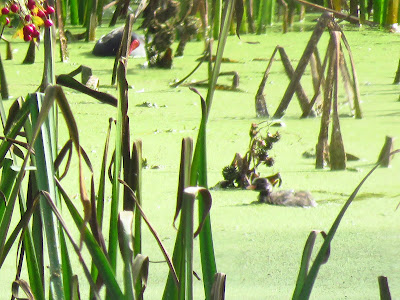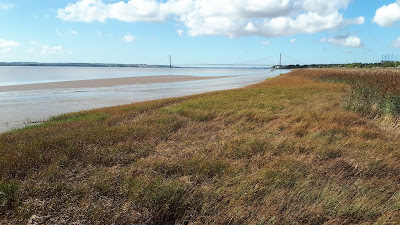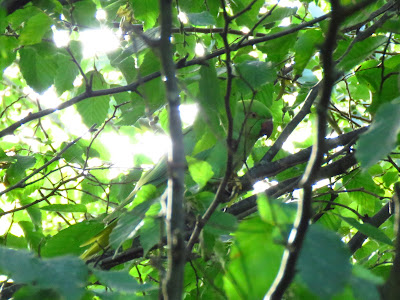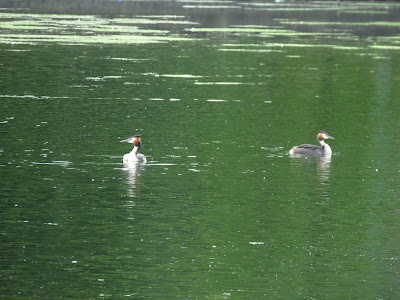
The forecast was for sunny spells and mild weather today, with barely a breeze, the Autumn Equinox. I had wanted to visit the Makro site in search of Speckled Bush-crickets, armed with bat detector, but instead of going there directly, I decided to take the train to Hessle and walk along the Pennine Way to St Andrew's Quay.
I was at Hessle at 9:00 and crossed the pedestrian bridge over the railway line and the A63, then the cricket field and soon reached Hessle Haven. Luckily the tide was out and a curlew was feeding in usual spot on the Haven. A Great Black-backed gull was also in attendance with Black-headed Gulls and Common Gulls.

View of the saltmarsh near Hessle Haven, with many Sea Aster seedheads
I took the detour around the industrial units and returned to the Humber foreshore. There was a steep descent but I took it to explore the saltmarsh. There were many clumps of Sea Aster, but so far no bush-crickets. When it was time to climb back onto the footpath, I realised it wasn't so easy, so I decided to walk along the saltmarsh and look for an easier way up. I'm lucky I did as I spotted a Sea Aster Bee, Colleted halophilus, feeding on a sowthistle.
Sea Aster Bee, Colletes halophilus.

Eupeodes latifasciatus
Small White, the most common butterfly today.
Sea Aster in bloom.
The views over the Humber and the Humber view were fantastic. I regularly checked the sides of the path with the bat detector. Shorttly after the Sea Aster bees I detected the call of Shor-winged Coneheads from the saltmarsh. As I scanned the exposed mud in the low tide, I spotted a mixed flock of Ringed Plovers and Dunlin, actively feeding.
Dunlin
Ringed Plover.
I reached the steps to Priory Way and here there were very accessible sections of marsh, with Long-winged Coneheads calling. I didn't manage to see any, but other invertebrates were more easily spotted.
Araneus diadematus, the Garden Spider.
Pisaura mirabilis, the Nursery Web Spider.
Araneus quadratus
Lesser Marsh Grasshopper.
Common Field Grasshopper.
Common Darter.
I'm not a big fan of the stretch alongside the Arco site. The path runs just by the A63, the noise is deafening and the passing trucks unsettling, but the Long-winged coneheads called all the way. Finally, I reached the wall by the Makro site. I had to stop and look back to take in the views. A large sand bank was exposed just by the shore. A mixed gull flock was spooked, but while I scanned the sky to find out the cause for their flushing, I found an Avocet, which settled in the middle of the sand bank. Avocet, Dunlin and Ringed Plover are new for the year for the Hull area.
Speckled Bush-crickets
The low brambles where I heard the first Speckled Bush-cricket
I entered the Makro site with some trepidation. I had been told that the site had had some large fires and I wasn't sure what to expect. It is a very large area and fortunately, large areas had escaped the fire. In the first clump of low brambles I pointed the bat detector to, I heard a 'chirp!', then another, a Speckled Bush cricket. I looked and looked and couldn't find it, so I carried on after recording the call.
A habitat shot of the Speckled Bush-cricket, with the brambles where the second Specked Bush-cricket was sat.
I was luckier with the second Speckled. A lovely bramble patch and close sound. I stood there and looked at each leaf of the bramble, and there it was! There was a long sunny spell and I could take photos, videos and recordings of the individual. The calls indicate there was another individual around, responding to the call, possibly a female.
Speckled Bush-cricket.
A Long-winged Conehead, the only one I saw today, joined the chorus from the same patch of bramble.
Spiked Shieldbug, a species I hadn't seen in Hull before.
I walked around the brownfield site, checking brambles and trees. The Speckled Bush-crickets occupied each suitable bit of bramble, but also birch trees. Other than then there were Long-winged Coneheads and Common Field Grasshoppers, but I failed to spot any Speckled Grasshoppers. It was time to head back and I walked along the new sea defences by St Andrew's Quay.
I was surprised to find more Speckled Bush-crickets in bushes and hedges by the wall and the pond, one of them was my best recording of them today, it was so close! How did the crickets got here is a bit of a mystery. The species is apterous, hence flightless, so dispersal is supposed to depend on individuals jumping or walking between suitable habitat patches. Although Speckled Bush-crickets are widespread and common in the southern half of the UK, the closest population is at North Cave Wetlands, where the earliest record is from 2002. There are no known populations in N Lincolnshire and they are very scattered north of the Humber. A possibility is human assisted dispersal. Eggs could travel with nursery plants, as hedges and trees are transported from nurseries down South for planting here or for sale in garden center (there is a B&Q in St Andre's Quay). Another possibility is train or road transport. Makro and St Andrews are right by the railway line and A63, so there is a chance of individuals being transported into the site as adults or young. Road transport is a know dispersal mode in the Southern Oak Bush-cricket. In any case, the population appears to be thriving, despite the fire, although it probably took many loses, given the area of brambles that was burnt.














































































